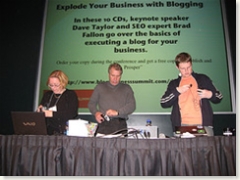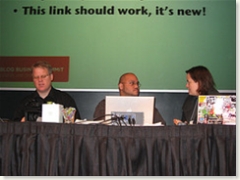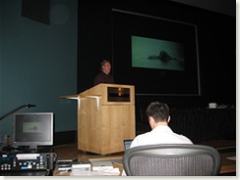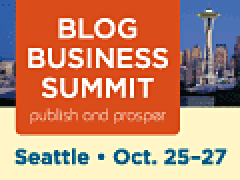
Headline in today’s National Post.
Trick or Treat!

 Michael O’Connor Clarke has posted on his blog that he will be joining Thornley Fallis tomorrow.
Michael O’Connor Clarke has posted on his blog that he will be joining Thornley Fallis tomorrow.
Whoopee!
We’ve been sitting on this news for several weeks as Michael worked his way through the process of obtaining his Canadian work permit. But now he’s official and it’s official.
Michael, we’re really looking forward to seeing you walk through the door tomorrow morning. And I’m sure that you’ll be greeted by a set of thousand watt smiles. Now, let’s have lots of fun with this social media thing!
 Matt Mullenweg and Liz Lawley closed out the Blog Business Summit with a look ahead to The Future of Blogging: Tools and Trends.
Matt Mullenweg and Liz Lawley closed out the Blog Business Summit with a look ahead to The Future of Blogging: Tools and Trends.
Liz Lawley:
Transparent functionality will be built into all tools. The easy integration of photos, videos, books, audio and collections that is offered in Vox, launched yesterday by SixApart, represents the new standard.
Liz also looks for a trend to Low Overhead Blogging: tools that enable you to easily add information into your blog. An early example of this type of tool is ShoZu, which enables you to easily move videos, photos and music while you are on the go.
The idea of Global Input will be hugely important. The ability to input from a mobile device. She points to Microsoft Aura! as the type of tool that will support this.
Selective Sharing will become an essential function. Sharing based on user defined groups. This also relates to Selective Publishing. As more people blog, they will demand a tool that enables them to selectively publish to one or another of their blogs.
Socially Filtered Search, the ability for me to filter my search results through my social network. When I am searching, I care more about what the opinion leaders in my space or my network think that I care about the universe as a whole. We need tools that let us build our own network for this purpose. And early entry into this space is the “Add me to your network” badge on del.icio.us.
Blogging technology was developed ten years ago. What is different today is that there is a mass audience that is using and reading them.
It’s not about the technology. It’s about the audience. And with the larger audience, we are increasing the opportunities to publish.
Before, the publishing Internet was restricted to 1%. Now, more people are able to join in.
And this expanding audience and subset of authors will shape the future.
Discussion:
Liz Lawley: I predict that within five years the word blog will become as irrelevant as the word homepage has become. This will simply be a part of what we do.
Dave Taylor: The future of the web is conversation and social networking. This will not be tied to any single tool.
Matt Mullenweg: If we are successful, in five years you won’t know what WordPress. It’s elements will be incorporated in all platforms and their operation will be invisible to the user.
And the final word on design goes to ZeFrank.
 Following his keynote, John Battelle returned for a panel with Tris Hussey and Dave Taylor on Blogging and SEO Strategies.
Following his keynote, John Battelle returned for a panel with Tris Hussey and Dave Taylor on Blogging and SEO Strategies.
Dave Taylor kicked off the the presentation with some tips:
SEO Best Practices.
A great place to learn how to do this is on Google’s Webmaster Central.
Is it worthwhile to include keywords in URLs? Notice that when you do a search, if the term is located in the URL it will be highlighted.
Two useful tests to determine that you are showing up in search engines is to type into the google search bar “site:[your domain]” and “link:[your domain]”.
Persistence is also a virtue from the perspective of the search engines. So, when beginning a new blog, recognize that you must blog for a sustained period of time before the search engines will start to rank you.
By installing code from HitTail, you can track the keywords that people search in coming to your page.
John Battelle delivered the Friday afternoon keynote address on Blogs, Search and the Changing Media Landscape.
“Why am I standing in front of you? I went to Berkeley ;-)” The story: Wired. Hotwired. Industry Standard. The Standard. The 4th. quarter of 2000 – out of a job. Back to Berkeley. The Search. Searchblog. Web 2.0 Conference. Federated Media Publishing.
The Internaet Economy is the third wave of tech and culture.
Search is still in its infancy. We use the command prompt/search bar. But the big difference is that we can enter plain language. And that’s a big thing.
Web 2.0 principles:
Search rules.
When it comes to marketing, search has provided an entirely new catchment point for marketing. We declare our intent in the search box. Then search organizes the data and presents it to us. In the old media days, we would buy commercial space on programs/media drawing a demographic. Now, with search we can buy keywords – expressions of intent. Intent drives content.
Search drives content to social media sites … where consumers expect all participatns to understand the mores of those environments. And they expect businesses to know what they want.
Marketing becomes a dialogue, not a dictation of one to another.
Traditional media and marketing is ruled by distribution: if you get that, you get attention. Now, attention is not controlled by distributors, it’s controlled by the consumer. There are now new centers of attention: search and social media platforms.
Content is once again king, and the landing page is queen. All businesses must join the Point-to Economy (links = votes = attention).
The promise of the web is the ability to know who you customers are and what they want and then draw them into converation. This requires business to think differently about retrn on investment. Marketing is about more than satisfying demand. It’s also about creating it. And how do you measure that?
New advertising campaigns must recognize all of these factors and break out of the old mindset (no more dinosaurs, Microsoft!)
 An all star panel – Robert Scoble, Andru Edwards and Mary Hodder – promised to reveal Podcasting and Video Blogging Best Practices.
An all star panel – Robert Scoble, Andru Edwards and Mary Hodder – promised to reveal Podcasting and Video Blogging Best Practices.
Robert Scoble: Start out by knowing the story that you want to tell. And edit it to tell the story from a distinctive perspective.
Expectations of production quality are going up. Rocketboom is using a $1,500 HD camera. While not everyone uses this quality of equipment, people expect better quality sound and images that don’t shake.
If you are using a cheap, on camera microphone, stay close to the subject to eliminate the ambient background noise. A wireless microphone is a worthwhile investment.
Mary Hodder: People will engage more with quality video. So, if you want to reach your audience, it is important to improve the technical quality of the video you post.
Robert Scoble: It’s still early days for video on the web. So, you can experiment.
Andru: Edwards: You can even use a still camera to capture short web quality videos.
Mary Hodder: Freevlog offers good resources for people interested in video blogging.
Robert: It’s a fun community right now. Because people are experimenting and trying things out.
Video bloggers can obtain sponsorship revenues by hosting their video blogs on revver.
For casual video bloggers, Robert suggests they look at bliptv, YouTube, google video or similar services. However, when uploading video to a service like YouTube, read the EULA (licence agreement) closely. You may be giving up the rights to your content.
Libsyn is another affordable solution for hosting podcasts and videos.
Mary’s company, dabble, is a search and sharing site for video. (Robert asked, so it was OK for Mary to talk about it.)
Maryam Scoble and some guy she brought with her presented Ten Ways to a Killer Blog. And they should know.
Maryam: Don’t start blogging when people tell you to do it. Do it only when you feel like it.
 Robert: How do you start a blog? Start by reading other blogs. By doing this, you’ll be able to identify styles of writing that you like. And you’ll also figure out whether you will be a good blogger. Because if you read blogs for a few weeks and find that you are not constantly commenting on other blogs, blogging may not be right for you. Blogging is about conversation and if you don’t comment regularly, you’ll probably write a “press release” style blog – and they’re really boring.
Robert: How do you start a blog? Start by reading other blogs. By doing this, you’ll be able to identify styles of writing that you like. And you’ll also figure out whether you will be a good blogger. Because if you read blogs for a few weeks and find that you are not constantly commenting on other blogs, blogging may not be right for you. Blogging is about conversation and if you don’t comment regularly, you’ll probably write a “press release” style blog – and they’re really boring.
Maryam: When you start to blog, you’ll develop friends and online relationships. You’ll learn and you’ll develop a network that will be valuable.
Robert: If you’re trying to build a business audience, become an authority on it. And be generous by sharing your knowledge. And link to others. This will draw people to you.
Maryam: There are two kinds of bloggers: Bloggers who want to make things, shake things and change the world. There are other bloggers who just want to talk to their friends, post their baby pictures, talk about books, and share with friends. But regardless of which type of blogger you are, there are some things you must know to make your blog popular.
Robert: It’s a google world. The first thing most people do when they are using the internet is to go to the search bar. The search bar has become the primary entry point for using the computer.
People who focus their blogs on a single niche seem to do better than people who write generalist blogs. If you understand this, you must pick a niche you can specialize in and develop a unique perspective. This will allow people to find you and to return to you.
Can people still do this or have all the niches been occupied by early bloggers? Mike Arrington and TechCrunch is an example of a late entrant who developed a distinct voice by picking a narrow niche and going even deeper.
When Robert began to blog at Microsoft, he began to link out. And as he did, people noticed and began to interact with him. As they did this, their comments moderated in tone.
Maryam: Even A listers maintain searches for their name. If you write about them, don’t be surprised if they comment on your blog.
Robert: Anyone can become an A lister with great content. For example, by having an interview with Steve Jobs.
He was challenged on this by voices from the audience. But Maryam came to the rescue.
Maryam: “I think it’s about coming up with consistent stuff. By covering interesting things and saying interesting things on a regular basis. It takes time.”
Robert: “There’s not just one A list. There’s 100,000 A lists. There’s one for every topic.”
Maryam: “There’s no one right way. I write about many different topics. My way is different from Robert’s.”
Admit your mistakes.
Maryam: “This is one of the reasons I didn’t want to blog. I read Robert’s blog and many of the comments were very harsh personal attacks. Because of Robert’s response, he gained credibility.”
Robert: “This is something I’ve learned. Richard Nixon didn’t admit that he’d made a mistake and people just kept piling on. When I make a mistake I try to admit that I’ve done it.”
Write good headlines.
Robert: In a google world, keywords and good headings count. In a world with much greater volume, you have to scan more rather than read deep. So, write good, descriptive headlines. They will stick out of the list. And they’ll be found more easily.
Robert showed the homepage of techmeme to illustrate that someone who writes good headlines will get noticed.
Robert: TechCrunch is a good example of this. When Michael Arrington started, every post had a graphic. This raised the bar. And today, you need to use a variety of other media – pictures and videos in particular.
Even if you are a text blogger, you can use a visual to stand out. This is why many text bloggers use lists. By breaking a text blog into a list, you can grab attention.
Robert pointed to crayon as an example of a company that is using Second Life to stand out. And GM uses flickr pictures.
Have a voice.
Maryam: Let people see you behind the posts. It will make people want to connect to you.
Get outside the blogosphere.
Maryam: By going to conferences, meeting other people, you will develop stronger relationships. And this still counts with blogging.
Robert: This is where the PR people miss out. They don’t realize that they need to go to conferences and meet people.
Market yourself.
Maryam: Recently, my blog was featured on the Best of MSN. I got 4,000 hits per day as a result of this.
Robert: Put your URL on your business card. It will help people to find you. Also, be creative with your business card. It’s those little touches that will help you.
Search google for Scoble business card tips.
Write well.
Maryam: Before you publish your post, do a spellcheck. Reread to be sure you said what you wanted to say. “Check your state of mind and state of heart” to avoid saying things you will regret.
Robert: Write short paragraphs. Put the most interesting information up top (the journalistic inverted pyramid.)
Expose yourself.
Robert: A lot of corporate types are very reserved about their writing. Every blogger has a knob that reads “safe” on one side and “interesting” on the other side. Don’t stay on the safe side. Spice up your blogs by showing something about yourself. Tell stories. Move the needle to the interesting side and you’ll get a more engaged side.
Help other people blog.
Maryam: Share what you’ve learned and help other people get into the community. That will build the network globally and for yourself as well.
Engage with commenters.
Robert: A lot of corporate ty
pes are skittish about going to other blogs and participating in the conversation. Simply having your own blog is not enough. You need to go to other blogs and comment to become known and to attract new readers to your own blog.
Keep your integrity.
Robert: “Dave Winer would keep telling me this.” You are what you appear to be. Don’t try to fool people or misrepresent yourself.
Thanks to Maryam Scoble and Robert Scoble for an enjoyable, engaging session by two people who really project happiness.
 The session topic: Branding in the Age of YouTube. The speaker, Ben Edwards, Director of New Media Communications at IBM’s headquarters in Armonk, New York and one of the key players in developing IBM’s social media strategy.
The session topic: Branding in the Age of YouTube. The speaker, Ben Edwards, Director of New Media Communications at IBM’s headquarters in Armonk, New York and one of the key players in developing IBM’s social media strategy.
Ben Edwards began his presentation by announcing that he is an imposter – a print journalist (14 years in print journalism, nine years at the Economist). Both he and IBM are relatively new to publishing.
What is IBM New Media Communications?
It’s really all about skills, developing enterprise applications for social media from internal communications to media relations and marketing. Ben is focused on the enterprise. This is different from the set of challenges and questions encountered when deploying social media outside of the enterprise. There are IT requirements that make it more complicated. But on the other hand, once these are satisfied, deployment is much simpler as the software is known, trusted and standardized.
Ben believes that there is tremendous opportunity for enterprises to “destroy costs” by adopting social media. And innovation can be encouraged in this process.
Finally, Ben hopes to estabish IBM as a trusted resource for corporations adopting social media.
Blogging is being rapadly embraced inside of IBM. At this time, they have about 3,400 active blogs. Of course, it’s very time intensive. And there is also a bit of an echo chamber with bloggers talking about other bloggers. Ben hopes to counteract the echo chamber by bringing even more bloggers online.
They have a podcasting pilot that has grown to 180,000 monthly downloads in less than 12 months in existence.
Since the beginning of the year, Wiki use has skyrocketed. There are now more than 70,000 users of Wikis within IBM. Ben himself uses four different Wikis.
The rise of social media heralds the advent of a new commuications paradigm. Social media represents a new way of communicating that will become the dominant way of communicating.
Social media are not about the technology.
Social media should not be thought of as new “channels” for distributing existing content and messages. That’s a very impoverished way of thinking about these technologies. They are fundamentally different with different economics, different expectations and different conventions.
The new communications paradigm:
Brands began life in consumer products as a symbol of quality (think Campbell Soup). By the 1960s and 1970s, brands began morphing into symbols of consumer identity (think VW Beatle, Marlborough Man). By the late 1960s, many brands were marketed on emotional attributes.
More recently, brands have become symbols of our social aspirations (BP – beyond petroleum; GE – ecomagination; IBM – innovation that matters.)
The prevailing orthodoxy of social media is that they will transfer control of the brand from the corporation to the consumer (Steve Rubel.)
Ben Edwards argues that corporations lost control of their brands the moment they became symbols of emotions and aspirations. There is a lot of volatility in brands. We punish them mervilessly. We fall quickly into and out of love with brands. When they no longer do things for us, wear the clothes we want, project the image we want, we punish them.
Since 2000, brand disasters include Gap, Sony, Kodak and Ford, each losing between 30% (Gap) and 70% (Ford) of their brand value.
As brands engage with social issues, brand insecurity may be worsening. Look at Merck or bp. Each is seeing their brand value destroyed by controversies around business practices and ethics – things that do not related directly to the quality of the product.
What has changed between us and them?
In the mass media world, the brand image was shaped through mass media and advertising. In the social media world, audiences of all kinds discover communities of interest and publish the brand to each other.
Look at brands on YouTube. People mash them up. They mock them. They celebrate them. They make the brands perform strange and unnatural acts (Coke and Mentos.)
And it’s not just happening on YouTube. It’s happening all over the Web. Technorati. myspace. orkut. flickr. circuitcity (customer reviews on its site).
With mass media, corporations would push out their messages and feedback would be throttled through mass media gatekeepers. With social media, there are an unlimited number of consumer feedback points.
With mass media, corporations attempted to dictate brand image through massive advertising. With social media, corporations may influence brand by inviting the audience to create and share the brand with them. Ford’s bold moves campaign is an attempt to do this.
Brands are at their strongest and healthiest when they speak about us and the people behind us. Social media allow us to open ourselves to the world.
Finally, Ben laid our an agenda for change:
 Day two started with Scott Niesen talking about Putting Web Feeds to Work.
Day two started with Scott Niesen talking about Putting Web Feeds to Work.
The program suggested that I’d learn “how RSS and ATOM web feeds can be used to effectively monitor your company’s reputation, automatically track competitors and industry trends impacting your business, and make project team communication more efficient.”
Unfortunately (in my view), Scott’s presentation sounded way too much as a sale pitch for Attensa. I’m sure it’s a good tool. But at a conference like this that I paid thousands of dollars to travel to and attend, I don’t really appreciate blatant sales pitches masquerading as a presentation.
Having said that, Scott did provide a good overview of uses of RSS feeds in a corporate environment.
Scott started looking at the needs of different audiences:
Webfeeds are the perfect tools for both of those needs.
Webfeeds have entered the workplace largely through the back door – through the efforts of employee bloggers. Now, like other tools that started in the consumer space, RSS feeds are beginning to find their way into the corporate environment.
Stages of RSS entry into the business environment:
The number one benefit of putting webfeeds to work is their use as an indispensable research tool. They can provide competitive intelligence. Scott’s company, Attensa, has been purpose built as a corporate tool for this purpose – tapping into 18 information sources, including google and the other search tools.
Feeds can also be used to monitor reputation, track buzz relating to markets, trends and people. Because bloggers tend to post frequently and quickly, they can also act as an early warning system, as news may break in the blogosphere long before it shows up on mainstream media.
Feeds can also support collaboration. The persistence of the information ensures that institutional memory is maintained in a searchable form. Subscriptions ease and speed information distribution. The delivery of information directly to interested users to be used when they are ready for it helps all team members stay abreast of developments. And the broad distribution of feeds behind the firewall can be used to build shared vision. Finally, all of this information taken together should provide the data for new insights.
Feeds can also be viewed as an indispensable delivery tool for training material, including podcasts, audio and video. Information can be delivered to a dispersed work force regarding sales leads, forecasts and opportunities.
RSS Feeds can also be used to support searching for information through indexing and tagging.
 One day down and another full – really full – day to go.
One day down and another full – really full – day to go.
This morning, I plan to take in:
That’s a lot. (Deep breath) And in the afternoon:
I’ll post after each session. Stay with me!